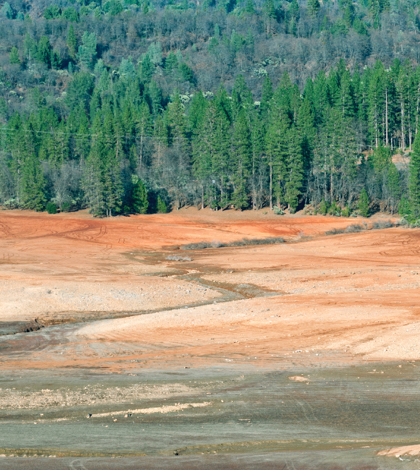The question of the day for Californians is whether the state’s five-year drought is over. Clearly it depends on who you talk with, but most water authorities say that in spite of an El Nino storm system in Northern California this year, overall the California drought persists.
On Wednesday Frank Gehrke, chief of the California Cooperative Snow Survey Program trekked out to manually measure the snowpack at Phillips Station, near Lake Tahoe, and found it at approximately 97 percent of normal or 87 percent of its historic average. The measurement is done annually on or around April 1 to provide an assessment of how much snow is in the Sierra mountains prior to the beginning of the winter snow melt and runoff. Though not the totals state and water officials had hoped for to restore California to pre-drought conditions, the annual measurement is up from a shocking five percent last April 1 when Gov. Jerry Brown stood at a snow-barren Phillips Station.
“The drought is not over,” Felicia Marcus, the State Water Resources Control Board chair, said in a statement. “While some parts of the state, primarily Northern California, have benefited from recent rains and snowpack, other parts of the state such as the San Joaquin Valley and Southern California continue to endure drought conditions.”
According to the Department of Water Resources previous state multi-year droughts have ended when the state’s precipitation totals around 150 percent of average. California’s precipitation currently stands around average thus far for the year.
Most reservoirs in Southern California remain well below their historical averages owing to an El Nino that has not delivered as much precipitation as anticipated and far below what Northern California has received.
The State Water Project has estimated that with the improved snowpack and some Northern California reservoirs experiencing flood control status farmers will receive an estimated 45 percent of their requested allocations this year. However, many farmers in the San Joaquin Valley and those in the southern part of the state will be relying on large amounts of groundwater to maintain their produce.
Although Folsom, Oroville and Shasta dams will either fill or come close to it the groundwater aquifers in most of Southern California remain depleted.
“We’re still going to be having a drought south of the Delta in the San Joaquin Valley,” said Jeffrey Mount, University of California, Davis professor emeritus and senior fellow at the Public Policy Institute of California Water Policy Center. “There is no doubt that we’re in much better shape than last year,” he said. Nonetheless, Mount noted, “An average year, in a portion of the state, is not a drought buster.”
The original state mandate issued by Gov. Jerry Brown a year ago to cut water use by 25 percent has since been reduced and Californians are now required to use 20 percent less. The State Water Resources Control Board (SWRCB) will review the water conservation mandate in May.
“It is not useful to focus on rain and snowfall on a weekly or monthly basis,” said Jonas Minton, a California water policy advisor with the Planning and Conservation League. “Californians need to realize that we need to improve the efficiencies of our water use in all years.”
Max Gomberg, climate and conservation manager with the SWRCB, said the board will likely move to “a more regional framework” in which different areas face different targets, depending in part on the health of their water supply.
“We’re sensitive to what local water agencies are going through, trying to keep customers conserving when the customers can see how much rain there’s been,” said Gomberg. But the board is not going to abandon conservation mandates, he said. He noted that when Gov. Brown called for voluntary conservation in 2014, “It wasn’t sufficient.”
Lester Snow, executive director of the Water Foundation, a Sacramento-based initiative focused on water sustainability, said “The state’s water management system is outdated and unable to address the new normal of unpredictable, extreme weather. It is time to invest in a 21st-century system that will ensure that California has enough water for its people, farms and environment.”
 California Water News Daily Your Source For Water News in California
California Water News Daily Your Source For Water News in California


